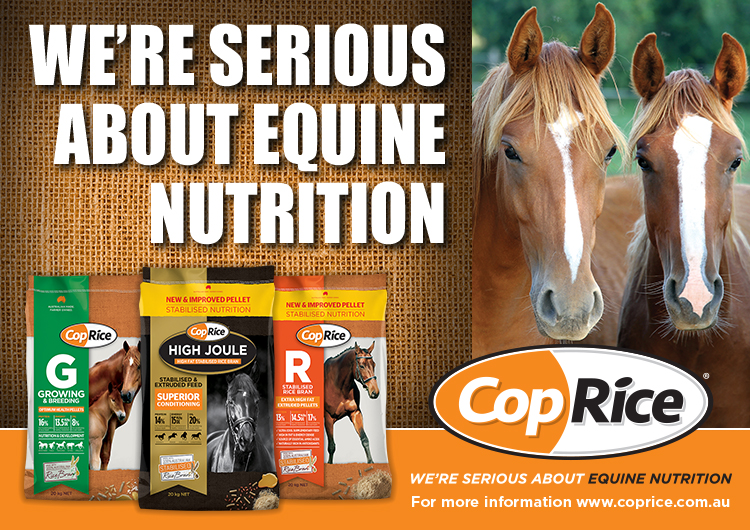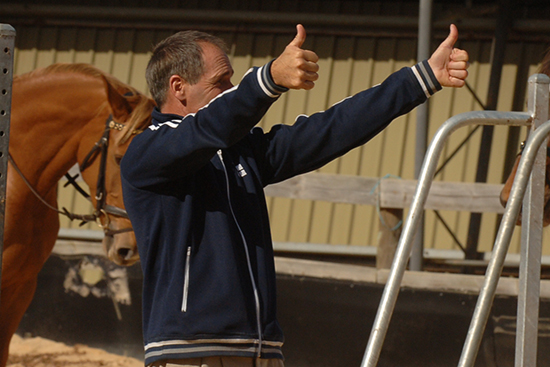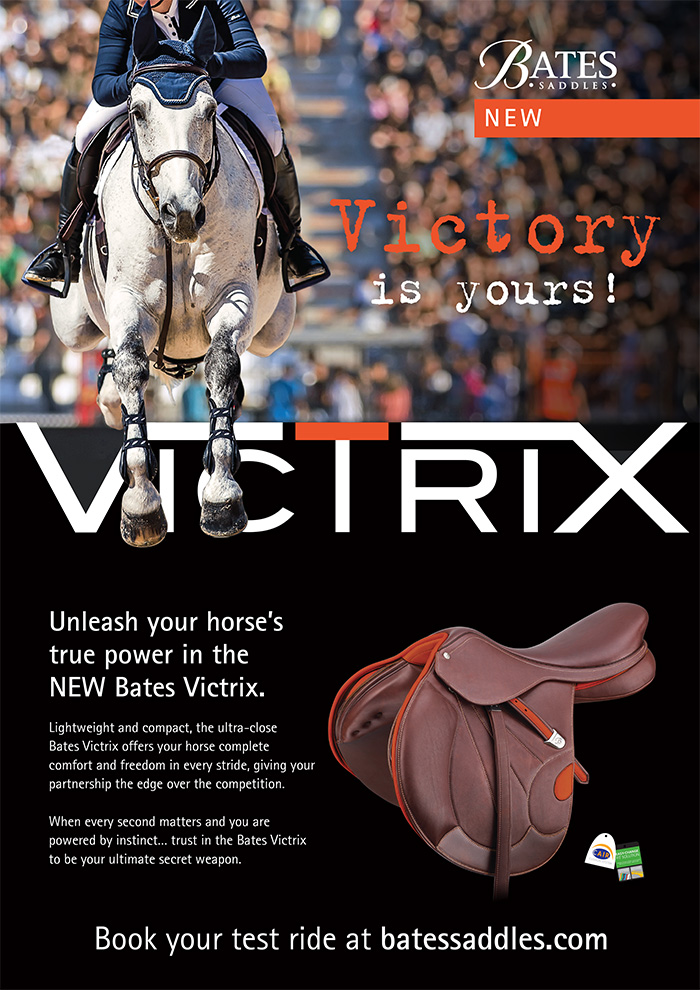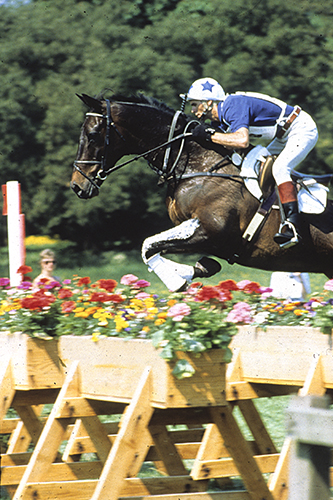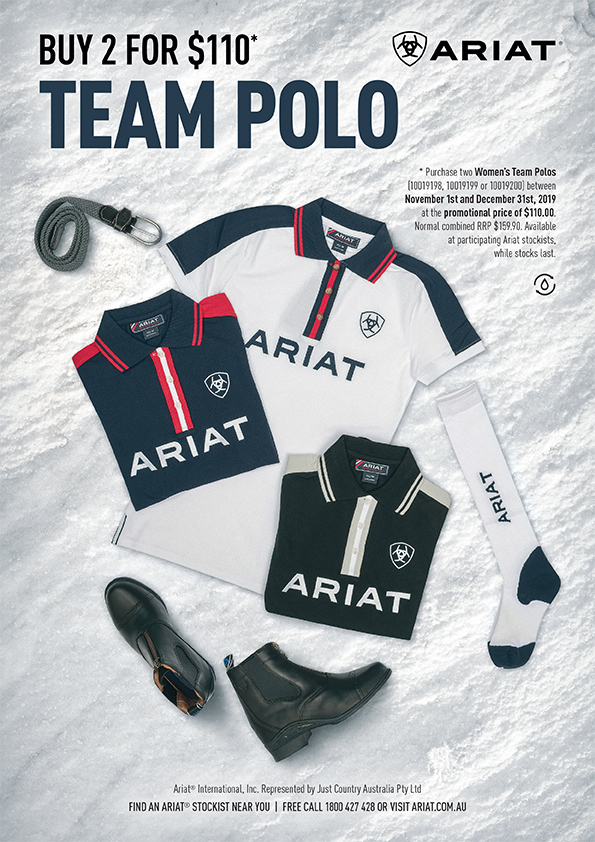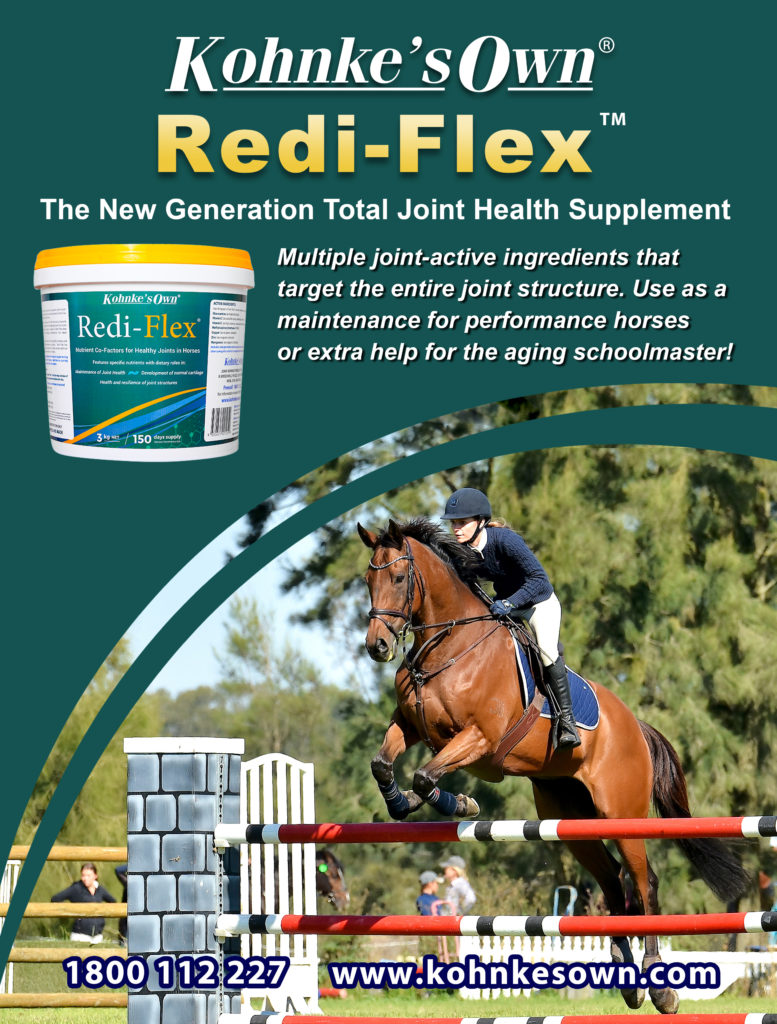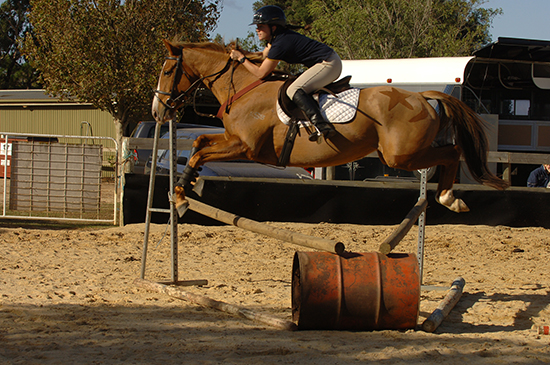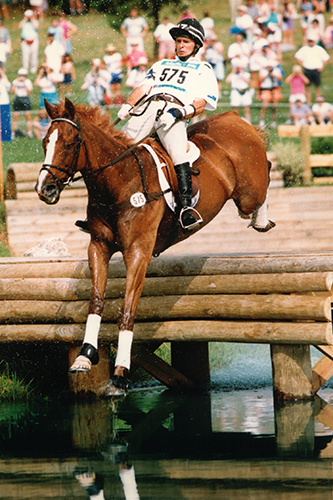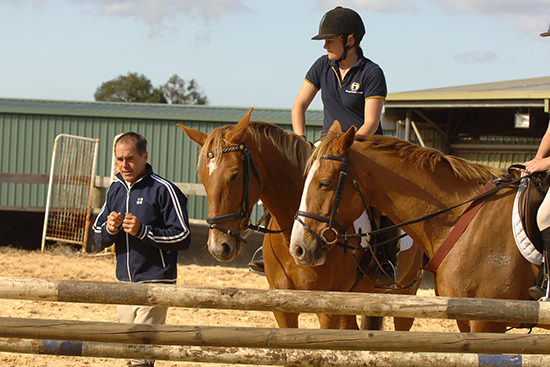 Story by Chris Hector and Photos by Roz Neave
Story by Chris Hector and Photos by Roz Neave
Blyth Tait is one of eventing’s genuine legends. A rider who produced two eventing megastars, and half a dozen stars, a rider who won a World Championship, and an Olympic Gold medal.
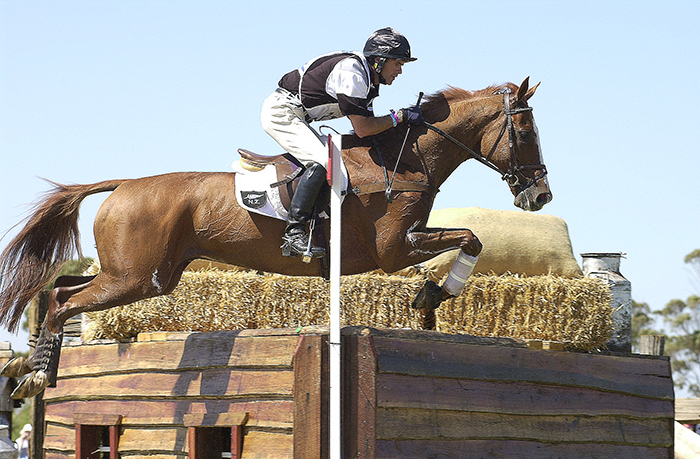
Blyth and Ready Teddy representing NZ at the Sydney Games
Blyth has always been a friendly and approachable individual, but it wasn’t until I saw him in action at Marcus Oldham College, that I learnt what a brilliant teacher he is!
Great teachers know their subject, are flexible in the methods they use to get their point across, but most importantly, they communicate with the kind of warmth and enthusiasm that makes their pupils WANT to try…
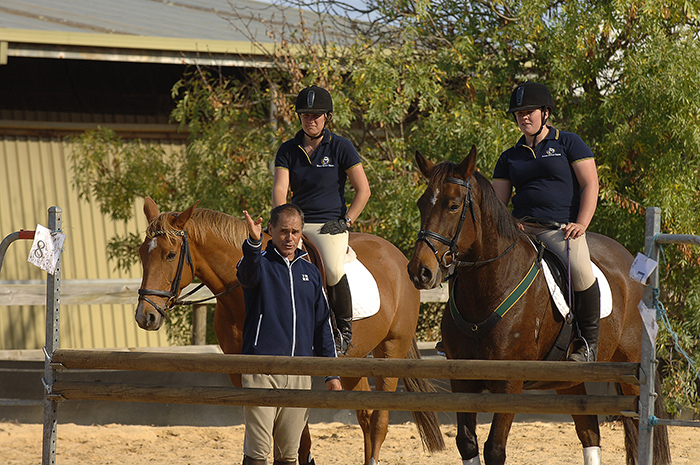
The pupils in the session we sat in on, were all students at Marcus Oldham: Alice Spry riding Mully (he’s the brown cross-bred horse) and a student from Canada, Samantha Barter, riding the six year old ESB Golden Hour, and Michelle Kavanagh riding the seven year old, ESB Golden Dust. The two chestnuts are full sisters and both were bred at the College. The three students are currently riding at Intro level.
The day before Blyth had been working on engagement and it was still high on his list of aims in today’s jumping session: “We want engagement and control. You can’t come with speed. The distance in this exercise is meant to be five strides, but I want you to do it in six. We want to take the speed out of the equation, if you have impulsion it will ride fine.”
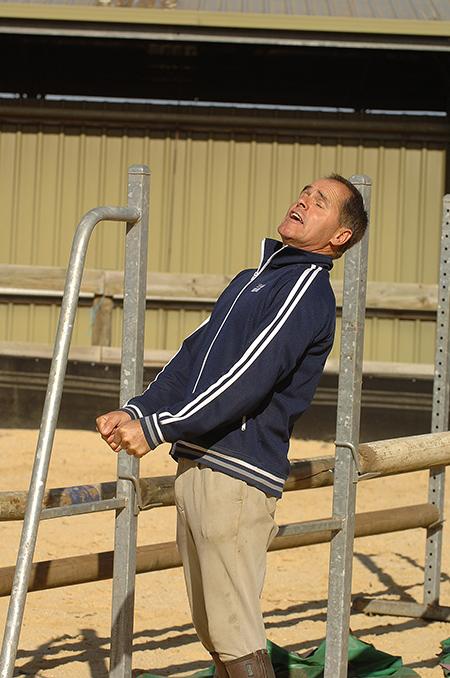
“STOP!!! You are forgetting the work we did yesterday. CONTROL THE ENERGY. Not coasting in neutral – there’s first gear, then second gear. It can be done if you don’t just sit there like a lemon. Create the energy, then allow, you can’t force it to happen.”
story continues below advertisement
And happen it does… but the teacher now wants to change the exercise, he wants his students to ride the double in five strides.
“Do we need to push? NO! Get the impulsion and just allow.”
Mully scatters the rails.
“Alice, what program were you watching on the TV then? You weren’t riding, just sitting back in the saddle watching…” But quick as Blyth is to criticize, he is just as quick with his distinctive thumbs up, when Alice and Mully ride it beautifully the second time around. “I got a thumbs up,” says Alice with a big grin.
For Blyth, the showjumping arena is the natural place to hone the skills needed for cross-country riding: “Cross country riding has its basis in showjumping riding. I was very much a showjumping rider before I was riding cross-country. I think you learn from experience, but it can be taught as well. What I am trying to get across to these riders who are at the early stages of their careers, is that if they have a good foundation based on balance and security, control, rhythm, engagement, impulsion – all of those elements that are required in every other phase as well, then they are going to have a fighting chance… and success breeds success across country. If you are having success, you are getting confident, your horse is getting trust. I don’t practice cross country a lot, but I train for cross country a lot, working on jumping technique through the arena and flatwork.”
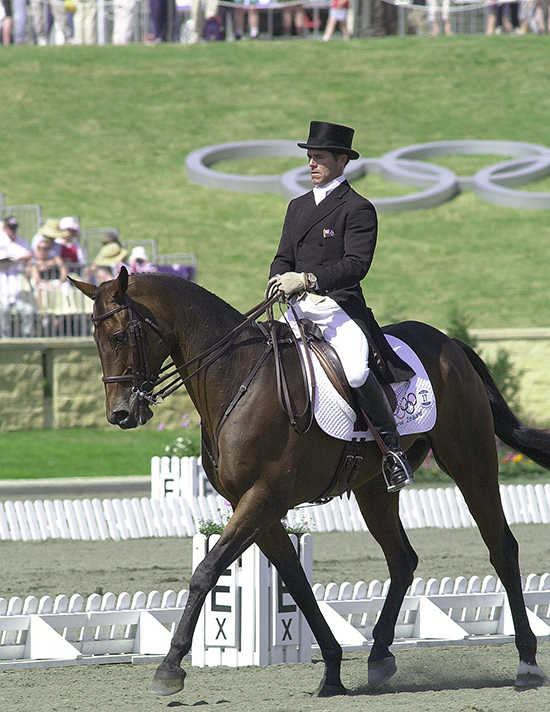
Blyth and Welton Envoy competing as individuals at the Sydney Games
All of that great Kiwi team came from a serious showjumping background…
“I think that is a very significant factor, me, Mark Todd, Vaughn Jefferis, Vicki Latta, lots of our eventing riders had success at the upper level of showjumping. You didn’t have the opportunity of specialising in eventing in those days because New Zealand being a small country didn’t have the numbers to sustain a big circuit of events, so we did both showjumping and eventing as part of our riding. All of us have slightly different techniques, slightly different personalities; we’ve all been shaped by the horses we rode. I never liked to ride a big, strong, powerful horse, I liked a quick athletic sharp horse because I’m a fairly small framed person, but if you have a good foundation the rest of it comes easy. Experience is really important in cross-country riding – there’s no substitute for experience, so you don’t learn cross-country without getting out and having a go. But the size is not important. One of my issues with my cross country riding throughout my career, was that I was a little defensive going into water, but the first serious horse I had was Messiah and he had a little bit of a water problem, and he was very quick and over-extravagant into water. I learned to be defensive to ride that particular horse because I had him for such a long time. I kind of learnt that technique from him so it is possible to ride a little differently from other riders, but really it is down to your basics.”
story continues below advertisement
Messiah – a World Champion for Blyth
Blyth is very strict on the rider’s hands, and jumps on any tendency to push the hands down in an effort to force the horse’s nose in. “If you do that, he’ll just go against you and come up further.
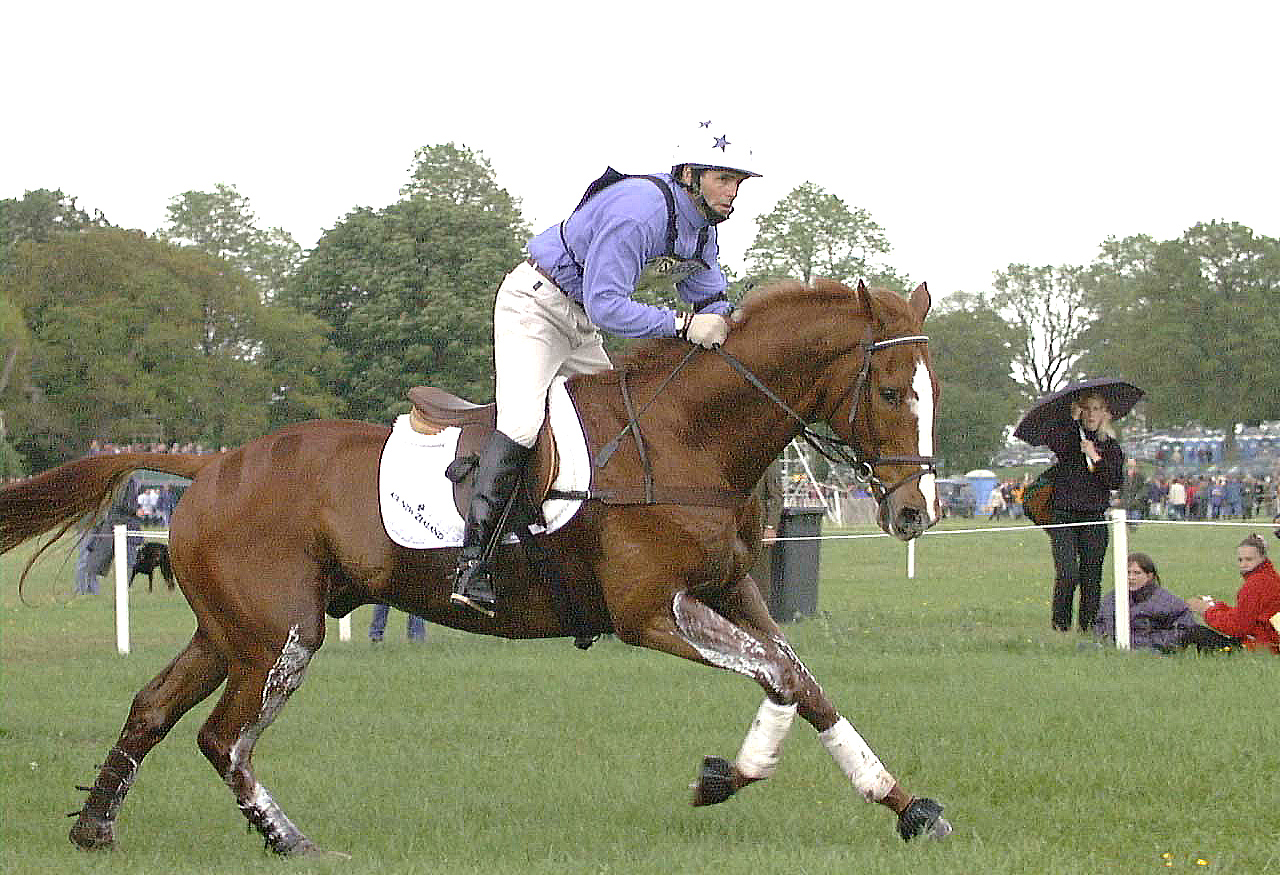
Blyth and Ready Teddy at Badminton
Don’t block your hands down, push up into your hands. Bend your elbows, we don’t pull down with our hands. Bent elbow equals a creative arm – not an arm that is creating resistance. Look at Sam, she’s riding with her hands out in front of her. I like that – she is going to ride the horse up into her hands…”
Now the exercise consisted of a triple bar over a ditch with water… well some green plastic if you want to get picky. And the riders were instructed to take this on a lengthening stride.
“Get the horse into your rein, and let it uncoil to a bigger stride. Take it on a lengthening stride and keep lengthening on landing. Don’t look for a stride, make one come up. Start in the corner and come out on a lengthening stride, and you will jump it like a bird.”
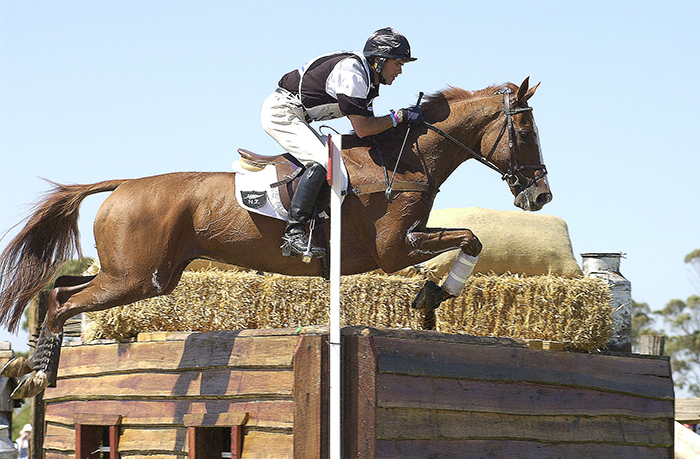
Team members for NZ at the Sydney Games with Ready Teddy
Were you always a calculating cool cross country rider rather than a gung-ho rider?
“You are only gung-ho until you make a mistake. You’ve got to have a certain amount of a training system. Obviously eventing is not for the faint hearted. I see people trying to go cross-country and they don’t really want to do it. And my advice to them is – don’t. You’ve got to be committed; you’ve got to be brave. That’s why riders are event riders, because we want to do the cross-country. You’ve got to want to do it. I’d rather see someone riding a bit gung-ho with perhaps a little lack of technique – within reason, not dangerous – than someone who had perfect technique, but not committed – because they’ll get into just the same sort of strife. You do have to be positive, but no, I was never gung-ho. I didn’t like making mistakes anymore than anyone else, whether it was a silly runout or whether it was a fall. You try and prevent things from happening, prevention is better than cure.”
story continues below advertisement
The next exercise was a bounce: “Obviously you come in shorter, bouncier, but all on a rhythm, with subtlety, not fighting, working with elasticity to give the horse the ride he needs. We must always be aware of the independence of our balance, of the importance of leg – you can’t create power with the seat – and our position, eyes up. Don’t try to jump the jump yourself, stay there, very still. If you stand in your stirrups, you will land on your knees – and what happens then? You fall over. It’s not eye, it’s technique and thought pattern that gets you to the perfect take-off point.”
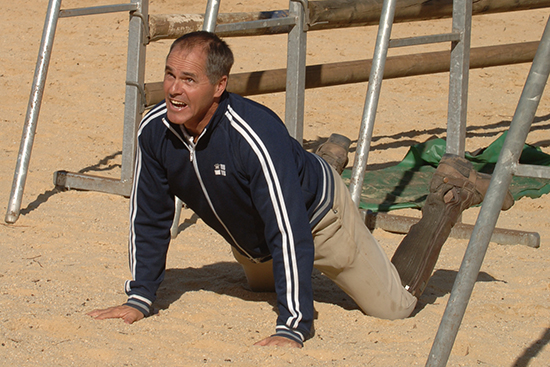 The next question was one of accuracy – jumping on the diagonal, and holding the line. “This is a test of straightness, a test of accuracy and control. You’ll need a slightly more engaged stride, more controlled – start it early, and maintain it throughout. Don’t turn onto the diagonal until you see the standards of the jumps all lined up.”
The next question was one of accuracy – jumping on the diagonal, and holding the line. “This is a test of straightness, a test of accuracy and control. You’ll need a slightly more engaged stride, more controlled – start it early, and maintain it throughout. Don’t turn onto the diagonal until you see the standards of the jumps all lined up.”
“Don’t worry if the horse gets a bit deep on take-off, you don’t want to do everything on a backwards stride. Let the horse learn to back up herself.”
And when they had ridden that straight line, Blyth made it just that bit more difficult with a witch’s hat right on the line: “It’s a big tree that has grown here since the last competition. So now you have to bend your line around it. These are just a few little exercises leading in the direction we are going. It’s not size that’s important, not jumping great big scary fences.”
story continues below advertisement
And to demonstrate this point, he lies a 44-gallon drum on its side to make a simple Apex fence: “I’m not trying to create a problem that has to be fixed, we’ll just start off thinking about Apexes. With an Apex you need to think it needs a lengthening stride, but it’s really quite upright. It’s between an upright and a spread. You need to keep the connection – it’s easier in trot than gallop, we’ll do it in canter.”
After a runout…
“When the horse runs out what do you do?”
“Re-present.”
“NINCOMPOOP! You FIX IT. If he runs off, you stop him and tell him he’s done wrong, that way he learns. One year at Badminton, there was a drop, down a slope, two strides to a skinny. I rode like an idiot, I was heading in the wrong direction, and my horse went – ping – and jumped it. He did that because of the education he’d had. That’s what we are doing today, all you can do to get better out there on the cross country course, is work more in here in the jumping arena…”
Blyth’s sort of horse – a bit small, a bit hot, and a whole lot of brilliant! Ready Teddy on his way to a gold medal at Atlanta…
“The courses you are going to jump have definitely become a lot more technical. The biggest change in the sport in my time was the improvement in the standard of dressage. When I first started my career, fifteen odd years ago, it was all about the cross-country riding and there were very few people who rode with the finesse you see these days. The cross country hasn’t changed a lot, it has got a bit more technical, they build a big big fence, maximum dimensions, nine foot wide ditch, six feet deep, palisade behind it, and everyone can jump it, so where do they go? They can’t just keep building them bigger and higher, so they go to more technical lines, turns, control, and that is what I am showing the riders today. There have been changes but subtle changes on the cross country.”
You always succeeded thanks to slightly hot Thoroughbreds, is that going to change – are Warmbloods the way of the future?
“Clearly you want a horse with a good aptitude that is very trainable, and if I was to change something I probably would have gone a little bit in that direction. I did ride Welton Envoy, who was as steady as a rock, absolutely outstanding on the flat. He wasn’t really my type of horse. I struggled with his balance on the cross country because he was a bit big for me, a bit strong for me. You can only do what you can do. It’s very rare you see a small girl on a great big horse or a great big guy on a small horse but if that works for that rider, that’s fine. I think Ready Teddy had a great temperament but he got very affected by atmosphere. At home he was pretty normal – but if you only turned up at the Olympics or the WEG, in front of a grand stand full of people, you got a very different picture of how he went. Hot horses are harder to keep secure than relaxed horses, there’s no doubt about that… everyone to their own, it’s just the way I did things.”
Want to breed the eventer of your dreams? There is a huge range of stallions to select from via frozen semen at International Horse Breeders…
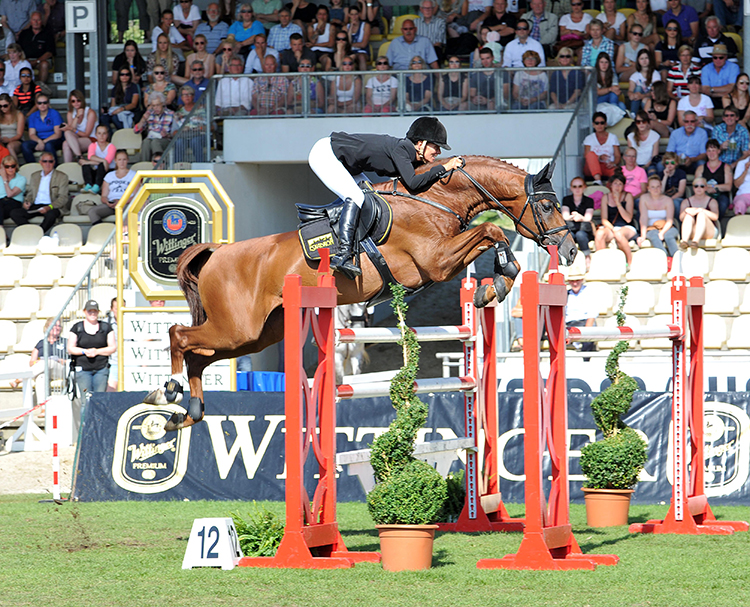
Stallions like Eva Bitter’s ride, Perigueux – an elegant and athletic performer…
This article first appeared in THM August 2007.


